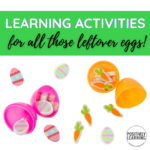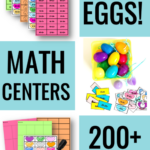
If you are anything like me, you have SO many leftover plastic Easter eggs lying around. I was on the search to put them to GOOD use!

Table of Contents
ToggleLet's face it, plastic Easter eggs seem to multiple every year and this many eggs take up quite a bit of space.
Luckily, these activities will keep your students learning and they can be used ANY time of the year.
I've divided up these plastic Easter egg activities into three categories:
The idea is to separate the eggs and create matching sets by writing on each half. Here's some ideas for making egg-celent matches (sorry, I had to):


Are there any ideas I need to add to this list?

I’m Jennifer and I was a special educator in the elementary school setting over the past decade. I entered the classroom every day dedicated to making learning inclusive AND engaging.













This website uses cookies to ensure you get the best experience on our website. See full disclosure here.
This website uses cookies to ensure you get the best experience on our website.
See full disclosure here.